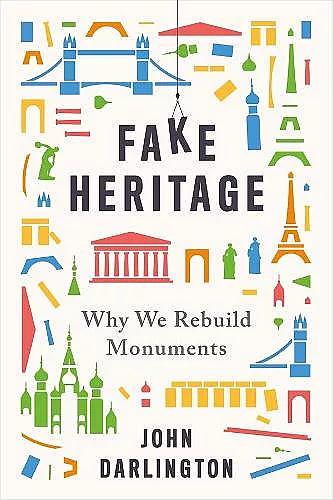Fake Heritage
Why We Rebuild Monuments
Format:Hardback
Publisher:Yale University Press
Published:13th Oct '20
£27.50
Available to order, but very limited on stock - if we have issues obtaining a copy, we will let you know.

The first survey of the many redesigned and imitation historical landmarks and objects that dot the globe
“John Darlington shows . . . it is not just written history that is malleable; it is also history on the ground, heritage in brick and stone, wood and metal.”—Simon Jenkins, Times Literary Supplement
What happens when the past—or, more specifically, a piece of cultural heritage—is fabricated? From 50 replica Eiffel Towers located around the world to Saddam Hussein’s reconstructions of ancient cities, examples of forged heritage are widespread. Some are easy to dismiss as blatant frauds (the Piltdown Man), while others adhere to honest copying or respectful homage (the Parthenon in Nashville, Tennessee). This compelling book examines copies of historic buildings, faux archaeological sites, and other false artifacts, using them to explore the ethics and consequences of reconstructing the past; it also tackles the issues involved with faithful, “above-board” re-creations of ancient landmarks.
John Darlington probes questions of historical authenticity, seeking the lessons that lurk when history is twisted to tell an untrue story. Amplified by stunning images, the narrative underscores how the issue of duplicating heritage is both intriguing and incredibly complex, especially in the twenty-first century—as communication and technology flourish, so too do our opportunities to be deceived.
Darlington is a well-travelled, polymathic archaeologist [and] a man of great energy and enthusiasms...who generously shows off his knowledge.”—Jonathan Meades, Literary Review
“[F]ull of comparably entertaining case studies — tales of human and architectural folly...It also warns the reader that little of the man-made world is left untouched by the curation, or falsification, of historical appearance.”—John Maier, Spectator
“[Darlington] concludes that whether fakery is good or bad is often nuanced, but that it’s important to “look closer, be curious, challenge” what’s in front of us to understand better what we’re being presented with. He’s right and this enjoyable book offers a good way to learn how to do that.”—Martin Bentham, Evening Standard
“As John Darlington shows in Fake Heritage, it is not just written history that is malleable; it is also history on the ground, heritage in brick and stone, wood and metal.”—Simon Jenkins, Times Literary Supplement
“Darlington's book [offers] an alternative view, one where architecture is equally obsessed with remaking its own past.”—Charles Holland, Apollo Magazine
“It is a good read, nicely illustrated and is timely, given the controversies about statues and the vexed ownership of the past.”—Bernard Richards, Oxford Magazine
"As the author adds examples he adds layers of complexity...The important thing is to be aware of that and to base one’s reaction to the presentation of the past on sound knowledge and appropriate perspective. Fake Heritage is an excellent way to start."—Historic House 'Editor's Pick'
“Concisely written, and the numerous colour images are excellent.”—Jerry Glover, Fortean Times
“To make a judgement, you have to inspect the actual building or monument to assess whether it is well or badly done...John Darlington’s book does just this, surveying the worldwide appetite for retro architecture from second rate theme parks to scholarly reconstructions.”—Marcus Binney, SAVE Newsletter
“Darlington’s writing is engaging...He presents a huge selection of case studies, drawn from ancient times to the present day. Entertainment value alone makes it a worthwhile read. There is much in it that, I suspect, most of us did not know.”—Robert Beavis, Chartered Institute for Archaeologists
“John Darlington…in this attractively produced, accessible book, has provided an engaging tour d'horizon with numerous examples.”—John Bold, Journal of Historic Buildings and Places
ISBN: 9780300246766
Dimensions: unknown
Weight: unknown
248 pages